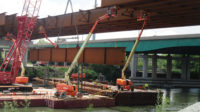Ongoing pandemic-related disruptions in the supply chain of a range of construction materials are undermining project demand, according to the Associated General Contractors of America and several contractor executives interviewed.
“Both today’s producer price index report and our survey results show that escalating materials costs and lengthening delivery times are making life difficult for contractors and their customers, including … facilities needed to get the economy back on track,” said Ken Simonson, AGC chief economist.
He refers to an analysis of data from the federal Bureau of Labor Statistics released March 12 and an association survey that said 52% of 1,419 contractor respondents had experienced delays due to shortages of materials, parts or equipment. Simonson added that owners and budget officials should continue to anticipate projects will cost more and have longer—and perhaps uncertain—completion times.
Construction executives affirmed the wide range of materials that are experiencing delays, including lumber, steel joists, insulation and stainless steel and PVC piping. Curt Hellen, president of Tulsa, Okla.-based Stava Building Corp., says high prices for some commodities, particularly lumber and steel, “are one of the biggest negative influences [on project costs] that we have right now.”
With steel and lumber product price spikes, Simonson said AGC has asked the Biden administration to consider removing tariffs in place on key materials, as well as taking other regulatory steps to ease shortages.
|
Click here for Full |
Construction project estimators say one of the biggest factors causing shortages is the continuing inability to ship available materials via rail or truck. “Due to container and trucking shortages being felt across the country, anything with significant shipping and logistics components can cause lead time issues,” said Josh Lawrence, vice president of preconstruction and chief estimator at McCarthy Building Cos., St. Louis.
Lawrence said McCarthy has used several strategies to mitigate impacts over the last year—including timing procurement, bringing on trade partners early, creating short windows to make decisions while bid pricing is still valid, locking in production slots and working with owner-clients to understand risks.
“The latest round of material price increases and availability concerns have only heightened our need to employ creative solutions to minimize these impacts,” he said.
Lawrence said steel that was ordered for a project was available but had not yet been processed when its plant shut down for two weeks. McCarthy’s on-site team worked with the manufacturer to find an alternative processing opportunity that would not cost the owner-client more time or money. In some cases, price increases on lumber and steel made switching to concrete the best option.
Open-book contracts, including guaranteed maximum price contracts, continue to be a good tool to minimize risk for trade partners, he said. McCarthy’s preconstruction group is educating its clients on market dynamics and creating contract language so that project participants not only share in the upside risk of material prices but also benefit from the downside.
“If easing of tariffs is put into place, we would expect pricing and availability to eventually begin to return to normal levels, which could certainly have a positive impact on our projects and the market as a whole,” Lawrence said. “However, with the shipping container and freight backlog that exists currently, bringing in significant quantities of overseas material would just add to that current challenge.”





Post a comment to this article
Report Abusive Comment